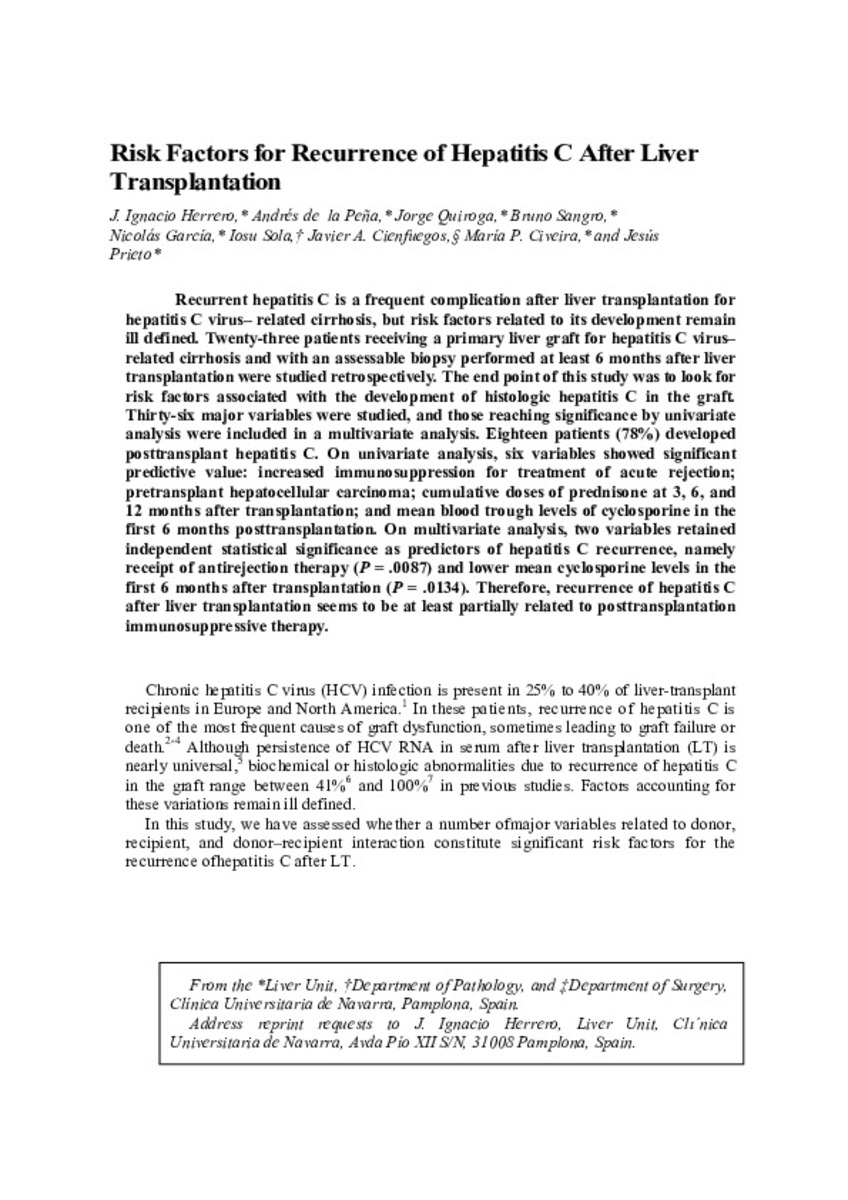Full metadata record
| DC Field | Value | Language |
|---|---|---|
| dc.creator | Herrero, J.I. (José Ignacio) | - |
| dc.creator | Peña, A. (Andrés) de la | - |
| dc.creator | Quiroga, J. (Jorge) | - |
| dc.creator | Sangro, B. (Bruno) | - |
| dc.creator | Garcia, N. (Nicolás) | - |
| dc.creator | Sola, J. (Josu) | - |
| dc.creator | Álvarez-Cienfuegos, J. (Javier) | - |
| dc.creator | Civeira, M.P. (María Pilar) | - |
| dc.creator | Prieto, J. (Jesús) | - |
| dc.date.accessioned | 2012-10-29T12:22:58Z | - |
| dc.date.available | 2012-10-29T12:22:58Z | - |
| dc.date.issued | 1998 | - |
| dc.identifier.citation | Herrero JI, de la Pena A, Quiroga J, Sangro B, Garcia N, Sola I, et al. Risk factors for recurrence of hepatitis C after liver transplantation. Liver Transpl Surg 1998 Jul;4(4):265-270. | es_ES |
| dc.identifier.issn | 1527-6465 | - |
| dc.identifier.uri | https://hdl.handle.net/10171/23506 | - |
| dc.description.abstract | Recurrent hepatitis C is a frequent complication after liver transplantation for hepatitis C virus– related cirrhosis, but risk factors related to its development remain ill defined. Twenty-three patients receiving a primary liver graft for hepatitis C virus–related cirrhosis and with an assessable biopsy performed at least 6 months after liver transplantation were studied retrospectively. The end point of this study was to look for risk factors associated with the development of histologic hepatitis C in the graft. Thirty-six major variables were studied, and those reaching significance by univariate analysis were included in a multivariate analysis. Eighteen patients (78%) developed posttransplant hepatitis C. On univariate analysis, six variables showed significant predictive value: increased immunosuppression for treatment of acute rejection; pretransplant hepatocellular carcinoma; cumulative doses of prednisone at 3, 6, and 12 months after transplantation; and mean blood trough levels of cyclosporine in the first 6 months posttransplantation. On multivariate analysis, two variables retained independent statistical significance as predictors of hepatitis C recurrence, namely receipt of antirejection therapy (P 5 .0087) and lower mean cyclosporine levels in the first 6 months after transplantation (P 5 .0134). Therefore, recurrence of hepatitis C after liver transplantation seems to be at least partially related to posttransplantation immunosuppressive therapy. | es_ES |
| dc.language.iso | eng | es_ES |
| dc.publisher | Wiley-Blackwell | es_ES |
| dc.rights | info:eu-repo/semantics/openAccess | es_ES |
| dc.subject | Graft Rejection/pathology/prevention & control | es_ES |
| dc.subject | Hepatitis C/enzymology/etiology/pathology | es_ES |
| dc.subject | Immunosuppressive Agents/therapeutic use | es_ES |
| dc.title | Risk factors for recurrence of hepatitis C after liver transplantation. | es_ES |
| dc.type | info:eu-repo/semantics/article | es_ES |
| dc.relation.publisherversion | http://onlinelibrary.wiley.com/doi/10.1002/lt.500040406/pdf | es_ES |
| dc.type.driver | info:eu-repo/semantics/article | es_ES |
Files in This Item:
Statistics and impact
Items in Dadun are protected by copyright, with all rights reserved, unless otherwise indicated.






